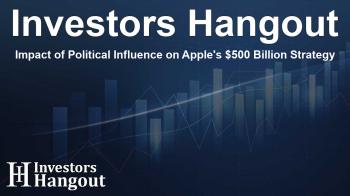Impact of Political Influence on Apple's $500 Billion Strategy

Apple's Bold Investment in the U.S.
Apple Inc. has recently made headlines with its substantial commitment to invest $500 billion in the United States over the next four years. This significant announcement reflects the company's ongoing transformation and expansion plan, showcasing its commitment to enhancing manufacturing capabilities and advancing technology initiatives across the nation.
The Political Landscape and Apple's Decision
Meeting with Political Leaders
The backdrop to this investment includes a meeting with President Donald Trump, where Apple CEO Tim Cook discussed the company's future and growth strategy. This interaction raised questions regarding the influence of political figures on corporate decisions. Critics wonder whether Apple's substantial investment was a choice or if external pressures played a role in this ambitious plan.
Expert Opinions on the Matter
Macroeconomic strategist Craig Shapiro voiced his concerns regarding the implications of such political involvement. While he acknowledges the positive long-term benefits for the country, he questions whether firms like Apple will ever return to their previous valuation multiples due to perceived coercion. Additionally, Shapiro speculates whether businesses will need to meet with political leaders to gain insights or approvals before proceeding with capital expenditure and hiring plans.
Investment Plans and Technological Advancements
Manufacturing Facilities and Research Development
As part of its investment, Apple announced plans to construct a new server manufacturing facility in Texas, aiming to bolster local job creation and technological infrastructure. The company intends to significantly enhance its footprint in the U.S. by doubling contributions to the Advanced Manufacturing Fund and focusing on crucial sectors like silicon production.
Expanding Data Centers
Furthermore, Apple's investment strategy includes accelerated development of data centers across several states, including North Carolina, Iowa, Oregon, Arizona, and Nevada. These expansions aim to not only improve the company’s operational capabilities but also enhance its research and development initiatives, particularly in artificial intelligence and innovative silicon engineering.
The Broader Economic Context
The implications of Apple’s investment extend beyond the company itself. The move is anticipated to stimulate economic growth and create a ripple effect in the manufacturing sector. As the company leads the way with such considerable commitments, other firms may feel pressured to follow suit, especially in a competitive economic landscape influenced by federal policies.
Market Reactions to Apple's Announcement
Stock Performance
Following the announcement, Apple's stock, represented as AAPL, saw a slight decline, dropping by 0.70% in premarket trading, contrasting with the modest uptrend of the Invesco QQQ Trust (NASDAQ: QQQ). Despite short-term fluctuations, AAPL has maintained a healthy position with a 35.54% increase over the past year, underlining the resilience and attractiveness of the tech giant amidst market uncertainties.
Analysts' Rating Overview
Currently, Apple enjoys strong support from analysts, with an average price target of $247.5 which indicates a general ‘buy’ sentiment. The ratings among leading firms like Citigroup, Needham, and Morgan Stanley present a promising outlook, suggesting a potential upside as business conditions evolve.
Conclusion
Apple Inc.'s commitment to invest $500 billion in the U.S. symbolizes not only its strategic vision but also highlights the entanglement of business and politics in today’s economy. As the company lays the groundwork for its future, it faces both opportunities and challenges in navigating this complex landscape.
Frequently Asked Questions
What is Apple's planned investment amount in the U.S.?
Apple's announced investment plan is for $500 billion over the next four years, aiming to enhance its manufacturing capabilities and technology initiatives across the U.S.
How might President Trump's influence affect corporate decisions?
Experts like Craig Shapiro express concerns whether political interactions compel companies like Apple to alter their strategic directions, potentially affecting their market performance.
What are Apple's expansion plans in the manufacturing sector?
Apple plans to build a new manufacturing facility in Texas and expand its presence with initiatives like silicon production and enhanced data centers across various states.
What is the current status of Apple's stock?
As of now, Apple's stock (AAPL) has seen fluctuations, recently dropping by 0.70% but remains significantly higher than year-to-date performance.
How have analysts rated Apple's stock?
Analysts maintain a positive outlook for AAPL, with an average price target of $247.5 and several ratings indicating a potential upside for investors.
About The Author
Contact Owen Jenkins privately here. Or send an email with ATTN: Owen Jenkins as the subject to contact@investorshangout.com.
About Investors Hangout
Investors Hangout is a leading online stock forum for financial discussion and learning, offering a wide range of free tools and resources. It draws in traders of all levels, who exchange market knowledge, investigate trading tactics, and keep an eye on industry developments in real time. Featuring financial articles, stock message boards, quotes, charts, company profiles, and live news updates. Through cooperative learning and a wealth of informational resources, it helps users from novices creating their first portfolios to experts honing their techniques. Join Investors Hangout today: https://investorshangout.com/
The content of this article is based on factual, publicly available information and does not represent legal, financial, or investment advice. Investors Hangout does not offer financial advice, and the author is not a licensed financial advisor. Consult a qualified advisor before making any financial or investment decisions based on this article. This article should not be considered advice to purchase, sell, or hold any securities or other investments. If any of the material provided here is inaccurate, please contact us for corrections.

